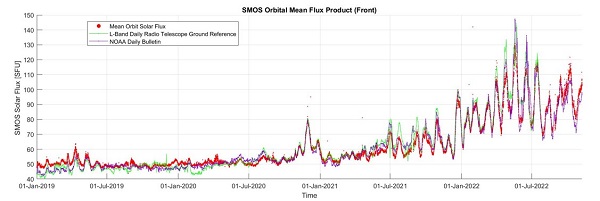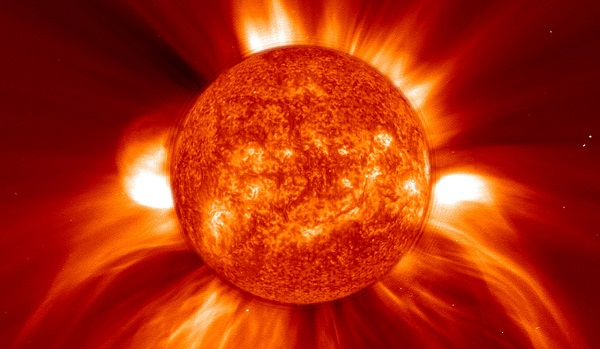- News & Events
- SMOS data advances space weath...
SMOS data advances space weather and ionospheric research
02 Dec 2022
ESA is taking steps to innovate ways to use SMOS data to support solar scientists and the space weather community, as set out in a workshop held recently in ESRIN.
The first SMOS for Space Weather workshop was attended by experts in the domain of space weather, solar interactions and the SMOS mission, to explore ways to use L-band SMOS data in space weather models and applications.
The Soil Moisture and Ocean Salinity (SMOS) mission is a member of ESA’s family of research missions - the Earth Explorers - which are focused on investigating key scientific questions about Earth’s system.
While L-band measurements from SMOS are successfully used to observe global variability in soil moisture and sea surface salinity, recent initiatives demonstrated that these L-band measurements can also be used to understand solar radio emission and its impact on Earth’s ionosphere.

At the workshop 60 experts from the space weather and SMOS community discussed topics such as deriving Vertical Electron Content (VTEC) maps and L-band Solar Flux from SMOS data products, as well as SMOS solar radio observations and their applications in space weather.
SMOS receives hidden information about solar flux
The Microwave Imaging Radiometer using Aperture Synthesis (MIRAS) instrument onboard SMOS is a passive microwave 2D interferometric radiometer (L-Band, 1.4 GHz, 21 cm) to observe Earth’s surface.
But MIRAS doesn't just capture signals emitted from Earth's surface, it also captures signals from the Sun. This information about solar flux - hidden in the L-band signal – is useful for space weather applications.
Nominal use of SMOS data tends to view this hidden information as noise and aims to isolate it to improve the quality of SMOS data products. For the space weather community, however, the extraction of this signal can lead to exciting new opportunities.
Our sun emits tonnes of radiation and energetic material in a constantly changing solar wind to cause dynamic conditions known as “space weather”. Heliophysics is the science of understanding the sun and its interaction with Earth and its solar system.
The Space Weather Research Group at the Universidad de Alcalá have validated the use of SMOS data for space weather observations [1].
The research team have used processed SMOS data to successfully detect space weather events, such as solar radio bursts from solar flares, which are associated with coronal mass ejections and can interfere with Global Navigation Satellite System (GNSS) and L-band air control radars.
They have also shown how SMOS products can detect the progression of the roughly 11-year solar activity cycle.

“We still need to understand many things in heliophysics and are very excited to have found a new dataset with SMOS. The workshop was valuable for us to share our needs with the SMOS mission team – for example, to examine certain solar events, it can be useful to separate data with circular polarisation,” says Consuelo Cid, Head of the Alcalá Space Weather Research Group.
SMOS L-band Solar Flux pre-operational products
Since the SMOS signal - with a frequency of 1.4 GHz - has information about circular polarisation, it can assess the impact of solar radio burst in GNSS and L-band air control radars. The group has also shown how the solar 1.4 GHz flux signal correlates to the kinetic energy of coronal mass ejections.
Understanding the mass expelled during solar events can help predict the effect of space weather, which in turn can impact the functioning of spaceborne and ground-based systems.

The pre-operational Solar Flux product derived from SMOS Level-1B data was presented by Serco Red Lab.
“The SMOS Solar Flux dataset is now available on a daily basis with a temporal resolution of 100 minutes, which is much higher than the usual 24 hours resolution from ground-based radio telescopes,” explains project lead Raffaele Crapolicchio from Serco.
“In the event of a solar radio burst, the dataset includes a bulletin message to identify time, duration, energy and polarisation of the burst. Such information can be used for space weather alerts, as well as ionospheric and thermospheric modelling.”
Ionospheric measurements with SMOS help improve its data processing
A presentation by researchers at the Universitat Politecnica de Catalunya (UPC), in Barcelona, showed how SMOS data are also being used for ionospheric studies, by deriving total electron content of the atmosphere [2].
As MIRAS receives the natural L-band emissions from Earth’s surface, this electromagnetic radiation passes through the ionosphere where it experiences a rotation known as Faraday rotation.
“Nominal operations of SMOS take ionospheric measurements from other sources to offset the effect of Faraday rotation in the signal. We are essentially inverting this idea, by examining the extent of the Faraday rotation in the SMOS signal to infer information about the ionosphere,” explains Ignasi Corbella, Professor at the Remote Sensing Laboratory at UPC.
Their results showed a correlation between solar events and an increase in Faraday rotation, as well as showing that SMOS derived VTEC measurements correspond very well with other ionospheric measurements.
Machine learning methods incorporate SMOS data in ionospheric modelling
The Space Geodesy group at ETH Zurich used solar flux time series derived from SMOS data to test how it could help with short term forecasting of VTEC. The study was carried out within ESA’s NAVISP CAMALIOT project.
“We investigate the feasibility of using machine learning for VTEC forecasting on varying spatial and temporal scales, by trying to incorporate geophysical information relating VTEC to solar and magnetic activity through additional models and indices, such as SMOS-based solar flux data,” explains project member, Grzegorz Kłopotek.
The team use solar flux time series derived from SMOS Level-1B data, which is a proxy of the solar activity and a high-quality alternative to commonly used indices.
“The SMOS Space Weather workshop was a good opportunity to become more familiar with the way the related products are derived,” adds Kłopotek, “The emphasis of the workshop was on the prospective collaboration and applicability of such products, which I also found beneficial.”
The first SMOS for Space Weather workshop makes it apparent that there is a huge interest for SMOS datasets in space weather models and applications, fuelling a variety of ESA funded projects. It is hoped that the workshop will spur on further innovation in this field and many future joint studies.
References:
[1] Flores-Soriano et al, “Validation of the SMOS Mission for Space Weather Operations.” AGU Space weather, 2021, Volume 19, Issue 3.
[2] R. Rubino et al, "Correcting the FRA Systematic Error in VTEC Maps From SMOS Radiometric Data", IEEE Transactions on Geoscience and Remote Sensing, 2022, Volume: 60.